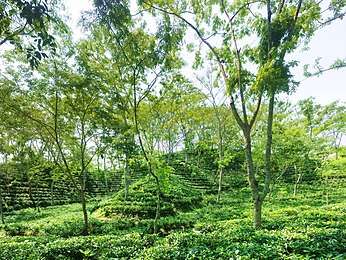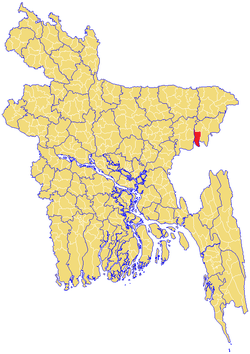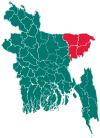Sreemangal Upazila
Sreemangal (Bengali: শ্রীমঙ্গল, romanized: Srimongol) is an Upazila of Moulvibazar District[1] in the Sylhet Division of Bangladesh.
Sreemangal শ্রীমঙ্গল | |
|---|---|
 Tea gardens of Sreemangal | |
| Nickname(s): Tea capital | |
 | |
| Division | Sylhet Division |
| District | Moulvibazar District |
| Government | |
| • MP (Maulvibazar-4) | Md. Abdus Shahid (Awami League) |
| • Upazila Chairman | Randhir Kumar Deb (Awami League) |
| Area | |
| • Total | 450.74 km2 (174.03 sq mi) |
| Population | |
| • Total | 230,889 |
| • Density | 512/km2 (1,330/sq mi) |
| Demonym(s) | Sreemangali, Srimangali, Srimongoli |
| Time zone | UTC+6 (BST) |
| Postal code | 3210-14 |
| Website | sreemangal |

History
It is said the name Sreemangal (or Srimangal) is named after Sri Das and Mangal Das; two brothers who settled on the banks of the Hail Haor.[2] A copper plate of Raja Marundanath from the 11th century was found in Kalapur. During an excavation at Lamua, an ancient statue of Ananta Narayan was dug out. In 1454, the Nirmai Shiva Bari was built and still stands today. Srimangal thana was established in 1912. The central town later became a pourashava in 1935. In 1963, two peasants were killed by police officers which kicked off the Balishira peasant riots. During the Bangladesh Liberation War of 1971, the Pakistani army reached Srimangal on 30 April setting houses on fire and committing atrocities against women. The East Pakistan Rifles camp and Wapda office premises were among the two mass killing sites. Two mass graves remain in Bharaura with a memorial in North Bharaura.[1]
Geography
Sreemangal is located at 24.3083°N 91.7333°E. It has 43,952 households and total area 450.74 km². It is bordered by Moulvibazar Sadar to the north, Tripura to the south, Kamalganj to the east and Chunarughat, Nabiganj and Bahubal to the west.[2]
Demographics
As of the 1991 Bangladesh census, Sreemangal has a population of 230,889. Males constitute 51.76% of the total population, and females 48.24%. This Upazila's 18+ population is 124,778. Sreemangal has an average literacy rate of 29.8% (7+ years), and the national average of 32.4% literate. Hindus constitute around 50% of the total population making up over one lakh, making it a city with one of the highest concentration of Hindus in Bangladesh.
Administration
Sreemangal has 9 Unions, 129 Mauzas/Mahallas, and 206 villages. The unions are Mirzapur, Bhunbir, Srimangal, Sindurkhan, Kalapur, Ashidron, Rajghat, Kalighat and Shatgaon.
Economy and tourism
Madhobpur Lake is one of the main tourist attractions in the area,[3][4][5] and is home to the Great White-Bellied Heron, the only confirmed site in Bangladesh.[6] The Baikka beel is also a nearby body of water and home to the Large-billed reed warbler.[7] Sreemangal has been nicknamed the tea capital of Bangladesh, due to the number of tea gardens in the area, and is the place of origin of the Seven Color Tea.[2] The Bangladesh Tea Research Institute in Sreemangal has made a number of contributions in evolving and standardising the quality of tea, and introducing its research findings to the tea industry of Bangladesh.[8] Pineapples from the Sreemangal area are known for their flavour and natural sweetness. In 2010, the Hum Hum waterfall was discovered and has attracted visitors from all over Bangladesh to Razkandi forest.
Education
According to Banglapedia, Victoria High School, founded in 1924, is a notable secondary school.[1] The Jamia Luthfia Anwarul Uloom Hamidnagar is a notable madrasa and Islamic centre in the Sylhet region.
Climate
| Climate data for Sreemangal | |||||||||||||
|---|---|---|---|---|---|---|---|---|---|---|---|---|---|
| Month | Jan | Feb | Mar | Apr | May | Jun | Jul | Aug | Sep | Oct | Nov | Dec | Year |
| Average high °C (°F) | 25.9 (78.6) |
27.9 (82.2) |
32.0 (89.6) |
33.3 (91.9) |
32.6 (90.7) |
31.9 (89.4) |
31.8 (89.2) |
31.8 (89.2) |
32.0 (89.6) |
30.9 (87.6) |
29.1 (84.4) |
26.6 (79.9) |
30.5 (86.9) |
| Average low °C (°F) | 8.9 (48.0) |
11.4 (52.5) |
16.9 (62.4) |
21.1 (70.0) |
23.2 (73.8) |
24.5 (76.1) |
24.9 (76.8) |
24.8 (76.6) |
24.5 (76.1) |
21.8 (71.2) |
15.8 (60.4) |
10.7 (51.3) |
19.0 (66.3) |
| Average precipitation mm (inches) | 12 (0.5) |
28 (1.1) |
93 (3.7) |
219 (8.6) |
366 (14.4) |
498 (19.6) |
380 (15.0) |
331 (13.0) |
260 (10.2) |
192 (7.6) |
35 (1.4) |
6 (0.2) |
2,420 (95.3) |
| Source: Climate-data.org | |||||||||||||
See also
References
- Chowdhury, Gopal Dev (2012). "Sreemangal Upazila". In Sirajul Islam and Ahmed A. Jamal (ed.). Banglapedia: National Encyclopedia of Bangladesh (Second ed.). Asiatic Society of Bangladesh.
- "Upazilar Potbhumi". Srimangal Upazila. Retrieved 12 Oct 2019.
- "Five Places to Go this Summer". The Daily Star. Retrieved 14 January 2016.
- Haider, M H. "DANGEROUSLY beautiful". The Daily Star. Retrieved 14 January 2016.
- Nakshi, Paromita. "Tourism Sector of Bangladesh: Potentials to Bring in Tk. 819 Billion by 2023". Bangladesh News Online. Dhaka Insider. Archived from the original on 21 December 2015. Retrieved 14 January 2016.
- Choudhury, Anwaruddin (2000). The birds of Assam. Guwahati: Gibbon Books & World Wide Fund for Nature-India, North-East Regional Office. p. 48. ISBN 9788190086615.
- "Rare Bird in Baikka Wetland", Daily Prothom Alo Archived 2012-01-07 at the Wayback Machine
- Minuddin Ahmed; AFM Badrul Alam (January 2003). "Bangladesh Tea Research Institute". In Sirajul Islam (ed.). Banglapedia. Dhaka: Asiatic Society of Bangladesh. ISBN 984-32-0576-6. Retrieved May 12, 2016.
